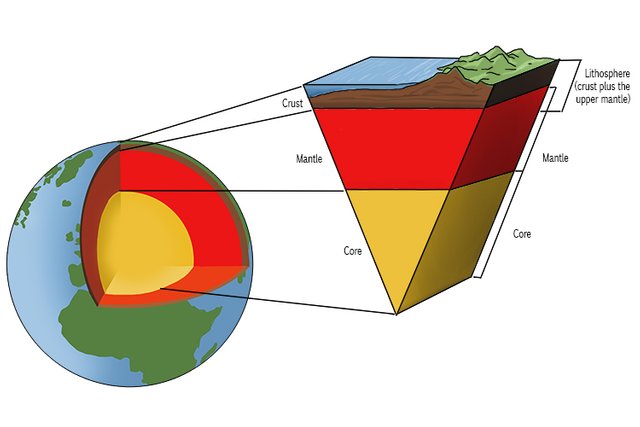The lithosphere shifts toward the north pole

Source
The cooling of the planet formed a single "shell", floating on top of the magma, without expansion joints. This promoted the partial "breaking" of that shell. The tectonic process and the arrangement of "slabs" that exchanged kinetic energy for different reasons began. The flooding processes of the planet were created, with emerged and submerged spaces. Continents, oceans and seas were formed, which evolved moving, joining, separating, until the conformation of the present time.
Japan moved with the great earthquake, the biggest earthquake in Japan. It was on March 11, 2011. It unleashed a disaster of its own and that was accompanied by a giant tsunami (tsunami in Japanese). Scientists informed us that they have determined that the Japanese archipelago shifted more than two meters.
At the United States Geological Survey (USGS) they calculated Japan's "walk". Satellite instruments were used. At this institute they compared the Terra satellite photos taken by NASA before and after the earthquake with the MODIS (Modular Imaging Spectroradiometry Spectroradiometer) technique. It was also demonstrated on the map of the Aerospace Information Authority (GSI), the geopositioning system station (GPS), all of which indicates that with that earthquake, Japan moved two meters and forty centimeters, at that time was the spokesman of the USGS Mr. Kenneth Hund.
Interesting follow-up by means of comparison of satellite images, with mathematical tricks demonstrate the direction and amount of the displacement, that Japan would have moved northward a distance of two meters and forty centimeters. These photos have been available for everyone's access on NASA's web portal, in which the displacement is illustrated. The first photograph was taken prior to the date of the March 11 earthquake, on February 26, 2011.
All of Japan was affected, but the reports of this disaster show that the Sendai region was the most affected, there was the tectonic focus or epicenter of the telluric phenomenon. But not only the fectation was restricted to Japan, because due to the extreme magnitude, the axis of our planet was affected, since the axis of Mother Earth also moved.
The earthquake reached an extreme category with a magnitude of 9 on the Richter seismological scale. The planetary consequence of this earthquake was the displacement of fifteen centimeters of inclination to the axis of rotation of Mother Earth (new official name of our planet by the UN since 2009).
Preliminary studies carried out on the same day of the earthquake by the Italian National Institute of Geophysics and Volcanology (IGGV) and the NASA Propulsion Laboratory determined that the alteration of the rotation axis. Earthquakes have this effect on the rotation axis; the higher the number on the Richter seismological scale, the stronger the earthquake and the more the axis shifts. In low magnitude earthquakes, the axis shifts by a very small fraction, which is imperceptible to mankind. With extreme earthquakes that reach 9 on the Richter scale, the displacement of the axis is more intense.
Let us remember that our planet, Mother Earth, rotates on itself around an imaginary axis called Planetary Axis, Mother Earth Axis, Earth Axis, World Axis or Pole Line. The axis has at its extremes the North Pole and the South Pole. Its usual inclination of these times we live in, is 23º27'0". The measurement or calculation after March 11, 2011 was 23.5º.
In geographic terms, a ground displacement of fifteen centimeters was determined. When Chile's four-minute earthquake of February 27, 2010, was determined to be 8.8 on the Richter Seismological Scale. For this occasion, the displacement of the mother-earth axis was half the displacement of the Japan earthquake of March 11, 2011.
Scientists therefore indicate that our planet, Mother Earth, is spinning faster, which results in a shorter day. The rotational spin was decreased by 1.6 millionths of a second in the Japan earthquake, compared to the decrease of 1.2 millionths of a second in the Chile earthquake.
The 2004 Sumatra earthquake shortened the record-setting day by 6.8 millionths of a second.
Axis displacement compensation on Mother Earth is to be expected. Since our planet is a system, then compensations occur to maintain normal rotation. In this case, redistribution of masses occurs to compensate for the loss through polar melting.
A new element arises for our knowledge, we wonder if the current polar thaws are a consequence, not only of global warming, but also due to the compensation of the displacements of the axis with earthquakes. With the compensation based on polar melting, this causes carbon dioxide (CO2) trapped in the ice to escape, which goes into the atmosphere and causes more greenhouse effect, increasing the heat on Mother Earth.
- With this new knowledge we consider that our continental drift has its axis to the north, in fact the current comparison shows a greater continental area to the north.
- The alteration of our planet's axis of rotation implies polar melting of compensation.
- The compensation of the displacement of the rotation axis, the polar thaw, determines the release of carbon dioxide (CO²) into the atmosphere.